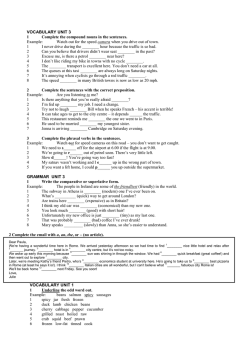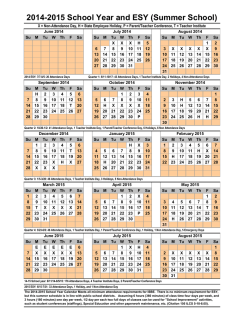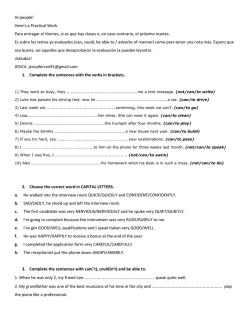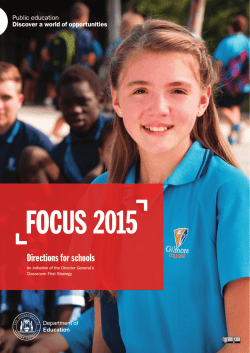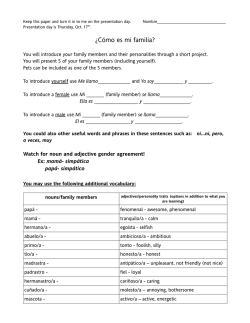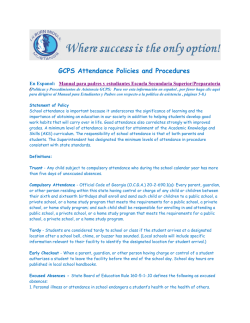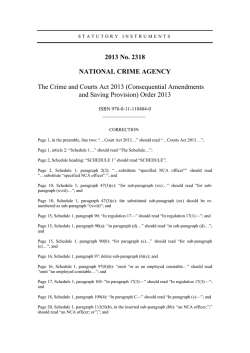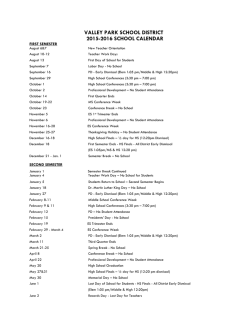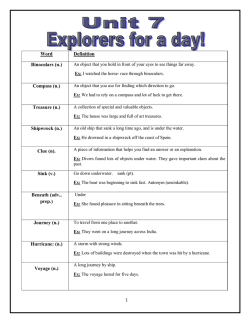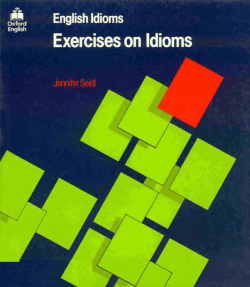
Year 7 Information Handbook
Welcome to Year 7 Parent Information Booklet 2014 AN A-Z GUIDE VISION STATEMENT: Students learn from the strategies that enable them to confidently and independently engage with the curriculum. VALUES: Achieve Respect Integrity Teamwork Health and Wellbeing YEAR 7 IN 2014 The teachers of Year 7 welcome both students and parents to Glenroy College for the 2014 school year. We look forward to working with you throughout the year. Starting secondary school is an exciting experience, with many opportunities for students and families. We hope that you take advantage of these opportunities and maximize your time whilst at Glenroy College. At Glenroy College we provide the best education for your child and encourage you, as parents, to build and maintain a strong, supportive link with your child’s teachers. This acknowledges the importance and value of education in your child’s life. The initial years at secondary school are an important step in your child’s schooling and form the basis for further study and career opportunities. Students have the opportunity of studying many exciting subjects, in which they can later choose to specialise. This booklet is an overview of some of the things that may be important to you now. If you have any more questions please contact the Year 7 Level Leader, Ms Christina Savva or visit the school’s website www.glenroycollege.vic.edu.au. 1 INTRODUCING OUR STAFF Ms Christina Savva Year 7 Level Leader Year 7 Teachers ENGLISH (ENG) HEALTH/PE HUMANITIES MATHS (HPS) (HUMS) (MAS) 7A Ms. Christina Savva (CSA) Mr Simon Povolo (SPO) Ms. Liana Bolger (LBO) Mr Aaron Mohan (AMO) 7B Mr Richard Van Rooyen (RVA) Ms. Johanna Simmons (JSI) Mr Michael Bretag (MBR) Mr Michael Bretag (MBR) Mr Simon Povolo (SPO) Ms. Trish Newton (TNE) 7C 7D Ms. Christina Savva (CSA) PERSONAL LEARNING (PL) Ms. Liana Bolger (LBO) SCIENCE INDONESIAN ARTS/TECHNOLOGY (SCI) (LOT) Mr Gary Kane (GKA) Ms. Rachelle Cole (RCO) TECHNOLOGY (TEC) Mr Bill Bain (BBA) Ms Silvia Ms. Kalevitch Harneet (SKA) Bedi (HBE) Ms. Harneet Bedi (HBE) Ms. Kate Gratton (KGR) DRAMA (DRA) Ms. Isabel Mangano Mr Michael Bretag (MBR) Ms. Harneet Bedi (HBE) Ms. Isabel Mangano (IMA) Ms. Harneet Bedi (HBE) Ms. Kate Gratton (KGR) Ms. Kristine Nelson (KNE) Ms. Lidia Tizian (LTI) Ms. Trish Newton (TNE) Ms. Emma Lynch (ELY) Ms. Emma Lynch (ELY) DRAMA (DRA) Ms. Isabel Mangano (IMA) DRAMA (DRA) Ms. Isabel Mangano TEXTILES (TEX) Ms. Teresa LaScaleia (TLA) ART Ms. Teresa LaScaleia (TLA) ART Ms. Teresa LaScaleia (TLA) TEXTILES (TEX) Ms. Teresa LaScaleia (TLA) *Please note this is subject to change If you have any concerns or queries regarding your child’s education, please contact the classroom teacher or the Year 7 Level Leader. We have a well-resourced Welfare Team to further support your child, the Personal Learning Teacher or Classroom Teacher can assist with a referral if necessary. The school telephone number is 9304 0400. ATTENDANCE AND PUNCTUALITY At Glenroy College we have an Attendance Officer – Adriana Castro. The phone is 9304 0410. If your child is absent or late to school or is missing from a class, a text message is sent to you. Please make sure your contact details are up to date. Absences and Notes A reminder that notes are required from home for Absences and lateness (contact the Attendance Office at before the start of the day but must be made within 24 hours of absence) being out of uniform (school and/or PE uniform), leaving school early (prior to leaving) and for all excursions. If your child is late due to an appointment please bring in the medical certificate when they arrive to school All notes should be delivered to the attendance officer in A Block 2 It is important to note the following: Students will be sent home with Parent permission. If students leave theschool grounds for any reason without permission, they are considered TRUANT. A student-parent-Level Leader meeting may be requested in cases of excessive student absences and/or lateness/early departures. Permission to Leave School—Appointment: If a student must leave school during the day for a pre-arranged appointment, a written note or phone call must be presented to the Attendance Office before 8:45 a.m. The note needs to include date, time of release, reason for absence, and telephone number to verify the release. The permission to leave the building must come from the Attendance Office. Arriving or Returning to School After School Starts If a student arrives after the start of the school day or returns to school the same day after an appointment, the student is to report to the Attendance Office and present the appropriate documentation for the absence. Please Note: If any student is feeling unwell throughout the day and needs a parent to pick them up, the student must report to the Attendance Office and a phone call will be made to a parent/guardian. AT NO POINT SHOULD STUDENTS BE CALLING/TEXTING PARENTS VIA MOBILE PHONES TO PICK THEM UP WHILST STUDENTS ARE IN CARE OF THE COLLEGE. PARENTS SHOULD NOT CALL OR TEXT THEIR CHILDREN EITHER. All contact should be through the general office or the attendance office. Extended family Holidays: If you do wish to apply for approval for an extended absence please complete a form which can be obtained from the attendance office (93040410) and submit the request to your Level Leader at least 4 week in advance of the proposed absence. If approval for an extended absence is granted: Students need to see each teacher before they leave so that they can fill in a “work to be completed” form On return from the absence, the student and a parent will be requested to attend an interview with their Level Leader to support their transition back into classes and to submit work that has been completed. Extended absence may result in the student having to repeat the year. How many days has your child missed in a semester? 0-7days 8-10days 11-20 20+ This is within normal range. A student with this attendance rate is able to take full advantage of the teaching and learning opportunities available to them. This attendance rate is below average. A student with this attendance rate could miss over one year of School learning between years 7 to 12. This is a poor attendance rate. A student with this attendance rate could miss one year and one term of learning between year levels 7 to 12. This is a very poor attendance rate. A student with this attendance rate could miss over two and half years of schooling from years 7 to 12 without realising. Being one and half hours late for school each day from years 7 to 12 is equivalent to missing one and half years of learning! 3 BEING INVOLVED WITH THE SCHOOL A great way to be involved with the School is through School Council where you can have a say in your child’s education. Parent and Community Engagement is a strong focus for the school this year is involving parents in the school and your child’s education. Throughout the year we will be running some parent and community conversations about how you can best help your child through secondary school and how we can best support you. Please keep your eye out for any notices sent home and in the school newsletter. If you are interested in being involved please contact Mr Paul Dingle, Principal at the school. BELL TIMES School starts at 9 am and finishes at 3.10 pm. *We encourage students to arrive at least at 8.45am PERIOD 1: 9-10.15am PERIOD 2: 10.15-10.30am LUNCH: 11.30-12.10pm Warning Bell (12.10pm) PERIOD 3: 12.15pm – 1.30pm RECESS: 1.30-1.50pm Warning Bell (1.50pm) PERIOD 4: 1.55-3.10pm BICYCLES Bikes can be used as a form of transport to and from school. However, they are not to be ridden on the school property at any time. A bike shed is provided and locked each day. Students must chain and padlock bikes in the shed. Helmets must be worn at all times. CANTEEN Students are encouraged to make a lunch order at the canteen in the morning before school starts. This will ensure that your child does not need to line up and receives their lunch promptly. COMMUNICATING WITH THE SCHOOL Effective communication with your child’s school is very important for your child’s education. There are a number of ways you can communicate with the school and your child’s teachers. 1. Phone: You can phone the office and you will be put through the person’s office and if they are not there you can leave a message on the voice mail. 2. Email: You can make sure that the school and your child’s teachers have your email and they can correspond with you by email 3. Planners: You can write notes in your child’s planner and correspond through the planner 4. Appointments: Make an appointment 5. Make sure you attend the Parent Teacher Interviews and Student Led Conference to get all the information about your child’s progress. Please remember that teachers and staff are often in class teaching so are not able to respond immediately to your request and at times, they may be in class all day so will not be able to respond until later in the day. If the matter is urgent, you can contact the General Office and let them know it is urgent. CYBER SAFETY Please make sure you read the Cyber Safety Use Agreement for Students with your child and that they understand their rights and responsibilities in using computers, iPads and phones at school. Some key things are: Do not let anyone else use your log on details or your password Understand that students must not use ICT to upset, offend, harass, threaten or harm anyone connected to the school or the school itself, even if it is meant as a joke. This also applies to home usage. While at school you must not access or attempt to access inappropriate, age restricted or objectionable material 4 CURRICULUM Subject Year 7 Art Drama English/EAL Health and Physical Education Humanities- Geography, History and Economics Languages: Indonesian Mathematics Personal Learning Science Textiles Wood work EXTRA CURRICULA ACTIVITIES Domain Full Year Semester The Arts The Arts English Health and Physical Education Humanities Languages Mathematics Personal Learning Science Design, Creativity and Technology Design, Creativity and Technology Instrumental Music (please contact Ms Kaklamanis) Debating & Public Speaking Sport Student Voice and Leadership DETENTIONS/RELOCATIONS If students are behaving inappropriately or not completing work, they may be required to complete a classroom detention with their teacher during a break or after school. If the detention is to go longer than ten minutes after school, parents will be notified in advance. If students behave inappropriately out of class or are late to school or out of uniform, they may be given a school detention which takes place during lunchtimes. Parents will generally receive an SMS for school detentions. If a student has been through a warning process about behaviour in a class and they continue this behaviour, they will be relocated within the classroom. If the behaviour continues after this, they may be relocated to another class. When this occurs, parents will receive a text message informing them that their child is required to come back after school for a conversation with the relocating teacher. Repeated relocations may result in parent meetings and/or suspensions. DROP EVERYTHING AND READ (DEAR) Drop Everything And Read occurs daily for the first 15 minutes of period 3 in all classes to support our students to read silently. Successful students read more than 1 hour every day. Each student should bring their own book to read. Students can borrow and return books in English and Personal Learning sessions or when the library is open. EXCURSIONS Excursions are an integral part of our curriculum and are aimed at supporting and extending the classroom programs. We appreciate the costs involved in these activities, so we will notify families as soon as possible. As our planning involves organising payments to transport companies, excursion facilities, etc, we ask that all monies must be received by the due date. Remember, for all excursions, these are part of the curriculum and attendance is required. HOMEWORK CLUB Year 7 and 8 students have the opportunity of participating in a structured homework program on Tuesday and Wednesday afternoons from 3.30 pm to 5.30 pm. Teachers are available to assist students with any work that they may have. Computers are also available for students to use and food and drinks are provided each week. Homework Club will commence in Week 3 of Term 1, notices will be sent out to students and will be in the school newsletter at the beginning of the year. 5 HOMEWORK PLAN The College policy on homework clearly states that homework should be a shared venture between parents, students and teachers. We believe that good study habits developed early will help the children as they move to higher classes. To achieve this: 1. Students have been provided with a planner and are encouraged to use it to record set homework and deadlines. 2. Students are supported in developing a homework plan. We ask parents to: 1. Check your child's planner on a regular basis. 2. Help your child to develop a homework plan (see below). 3. Use your child's planner to communicate with teachers. The College policy provides guidelines for the minimum amount of time to spend on homework/home study. For year 7 students, this amount is 30 minutes per night. *The Homework Policy is currently under review along with the Non Submission of Work. Parents will be notified of any changes. IMPORTANT DATES TERM DATES 2014 Term 1: Term 2: Term 3: Term 4: Wed 29th January to Fri 4th April Tues 22nd April to Fri 27th June Mon 14th July to Fri 19th September Mon 6th October to Fri 19th December STUDENT FREE DAYS The following dates are student free days in 2013: Monday March 10th Labour Day st Tuesday, 1 April Parent Teacher Interviews* Friday 18th – Monday 21st April Easter (in the school holidays) Friday April 25th ANZAC Day Monday June 9th Queen's Birthday th Thursday 11 September Parent teacher interviews Monday November 3rd Staff Professional Learning Day (curriculum day) th Tuesday November 4 Melbourne Cup Day *Other student free (Curriculum) days and details will be announced in newsletters, on the website and through notes home throughout the year. INSTRUMENTAL MUSIC At Glenroy College, students have the opportunity to join the College Band, Guitar & Drum Ensembles, College Choir and also take individual lessons on flute, clarinet, saxophone, trumpet, keyboard/piano, drums and guitar. Lessons are half a period per week during class time and the cost is $25 per term. Performances include school and community events such as the Victorian State Schools’ Spectacular. AMEB exams are also offered. Instrumental music lessons are compulsory for the Accelerated Year 7 class. A refundable deposit of $50 applies for instrument maintenance & materials. iPADS AND LAPTOPS Once the Student Resource Charge has been paid, Year 7 students are able to be part of the iPad program. This involves purchasing an iPad over 2 years. More information about the iPad program is available at the General Office. Please remind your child, that all students have signed an Acceptable Use Policy when using their iPads and computers. At Glenroy College, all students are to use technology appropriately and for educational purposes only. 6 LOCKERS All students have been allocated a locker in A block with ample room for books, school bags and change of clothes. Students must have a sturdy lock. Students are responsible for their locker for the rest of the year and should report any problems immediately. Combination locks are available for purchase at the General Office, these are the recommended locks for students to have. All students who have paid their Education Resource Charge receive a Combination Lock. NEWSLETTER AND WEBSITE The school produces a monthly newsletter that is available to view on the School’s Website at http://www.glenroycollege.vic.edu.au/school-newsletters . The school’s calendar is also updated regularly on the school’s website at http://www.glenroycollege.vic.edu.au/school-calendar-and-events . If you would like the newsletter emailed to you, please provide the school with your email address on the survey attached. PLANNERS All Year 7 students should have planners. It is the student’s responsibility to keep the planner up to date and ensure that it is taken to all classes and home each night. We expect all parents to check planners regularly, use the planner as a way to communicate with teachers and encourage good work habits at home. If your child loses their planner, they will be expected to buy a new one, they are available at the General Office. We are encouraging all students to put all notices, newsletters, etc in their planners to ensure they get home. UNIFORM The College Uniform guidelines have been included in this information pack. All parents and students are reminded that all students are required to wear their School Blazers to and from school (except if it is over 28C). The Uniform Shop is open in A block Tues and Fri from 3.30-5.30pm, appointments can be made outside these times. The supplier for Uniforms is JSF Clothing, contact is 0417 528 259. Second-Hand Uniform & States Schools Relief. There are some items of second hand uniform available, this depends on supply. Any queries can be made to Suzanne Kimpton 8.15-9am and 3.15-430pm at the General Office. For extreme financial difficulties some support through States School’s Relief is available, but this is limited. Contact Suzanne Kimpton as above. VISITORS/SCHOOL GROUNDS All visitors to the school must first report to the General Office and obtain a Visitor's Pass. When arriving, please sign in and if appropriate a pass wil be issued from the office and sign out when you leave. Students are not permitted to leave the school grounds at any time during the school day. If a student needs to leave early, a note must be provided from home with details and times. ON A FINAL NOTE Below are some activities you can do with your child to support their learning. If they are reading anything you can do some of these activities with them. If you have any questions about these please contact your child’s English teacher. One of the most important things you can do to support your child through Secondary School is what is called ‘Dinner Time Conversations’. These don’t necessarily need to be at dinner; they could be in the car on the way to school but are those conversations you have where you show an interest in what they are doing at school. These conversations are so important for your children to see that you support them and it crucial for them in articulating their learning. Being able to talk about what they learned is a way to really consolidate what is happening for them in school. So every day if you can ask them questions like: What was the best thing you learned today? Tell me something that was different that you did at school today? What was the most interesting thing you did today at school? Describe a concept you learned today in Maths, English or Indonesian etc… 7 These sheets have been provided to you to help with homework and reading activities with your child READING ALOUD ACTIVITIES Task Questions the text answers Activities Model reading aloud Shared reading Choral reading In pairs or groups they read text aloud. Allocate one or two sentences to different people in the class. One person to pick out the key words and ask others to guess the words Students read a small portion of text at a time. Multiple or repeated readings; read the same text more than once. Class can be divided into groups and each group reads a section of the text aloud (boys alternating with girls, right side alternating with left etc). Teacher can tape students. Listen to themselves as they read. Prepare a spelling list of key words and choral read with the class. Pre- Read 8 Senior classes read their text book aloud and become familiar with language and terminology unique to that subject. Model oral reading as often as possible and draw attention to the reading actions that need to be learnt. (eg. Following the words with a finger or transparent plastic or bookmark.. Eyes scanning the page.) Students become aware of the actions that they can use when they read. Readers discuss with others the actions that they use and then they try out the actions and perhaps take them on for themselves. Re-read After reading a sentence aloud, ask readers, ‘What question/s does this answer for us?’ This helps them analyse the sentence in terms of its purpose and encourages them to be more active readers. A useful activity can be students are given a set of sentences and a matching but jumbled set of questions and link each sentence with its question. Another can be in small groups write the question that each sentence answers. In pairs, one student reads a sentence and the second decides the question that would be asked to get that answer Re-read parts that don’t make sense, self- correct, guess unfamiliar words and check guesses about the text Re-read the text three times to achieve optimum comprehension. Re-read a section of text several times to gain fluency, to pick up the thread of the reading Poor readers start reading single words; sentences; paragraphs in order to build up confidence. Re-read and monitor sentences for meaning Set students reading homework or practise in pairs before they read aloud in class (from one sentence to a page). Organise the print to be read. Think ahead, predict what might happen next Be like a detective-Ask “Why did that happen?” and inferring Read between the lines How do I skim, scan? Bounce Reading Teacher reads, then says “bounce” and chooses the next reader to read. Once they’ve read they say “bounce” and choose another reader and so on. You can vary the game by dividing the class between boys and girls, left side to right, ect Silent reading Readers should be encouraged to read to themselves. Talk to oneself when reading, paraphrase Visualise Ask to students to close their eyes and think of a scene or character or event from the text they are reading. Visualise or ‘make a mental picture’. Put yourself into the context Set your pace Students read at own pace and change pace if they want to. Students can stop at any point and say, “that didn’t sound right/ make sense” etc. They may need to reread set text. Praise the reader Praise the reader for re-reading, guessing, taking risks, changing pace and the help the reader to see that attempts at “playing the rules” The teacher should coach, coax, support, praise, model, decode and correct pronunciation in a supportive manner. Experiment and risk Post reading Dictation Get students to see reading as a problem- solving activity in which they are trying to guess the writer’s intention. Solo reading aloud: alone on tape. Students ask themselves: Does this agree with what I thought it might say? What are main ideas so far? How have the ideas changed? What ideas can I link? Readers can use semantic mapping procedures. Simple dictation where the teacher dictates to the class who write it down. Student led dictation. (one student dictates and another writes) Paired or group dictation. Students decide whose summary contains the key concepts and that person dictates their summary to their group. Running dictation (kinaesthetic activity) o Have the text on posters in different parts of the room o Divide class into teams of 3 o Person 1 is the scribe o Persons 2 and 3 are stationed at a poster o Person 2 runs back to tell scribe what to write o When s/he returns, person 3 runs to the scribe to continue the dictation. o 2 and 3 continue to do the runs until the text for the group is complete. o (The scribe position can change during the dictation.) o All students check the spelling and punctuation at the end and submit to the teacher. o Prizes can be used for motivation. 9 SAY QUESTIONS TEXT ANSWERS Task Match sentences with questions 5W&1H After reading a sentence/text aloud, ask readers “What questions(s) does this answer for us?” For example, use the 5 Ws (What, Where, Why, When, Who) and I HOW question Write Questions In small groups or pairs write down the question that each sentence answers. Predicting Questions In pairs one student reads a sentence and the second decides the question that would be asked to get that answer. Ask what questions the picture answer. Reflection 10 Activities Give a set of sentences or statements and a matching but jumbled set of questions and link each sentence with its question. Students reflect on how asking questions assist them to read and the types of questions particular sentences might answer. E.g Student pretends they are a teacher and they need to create a set of questions for their class; what would they look like? PARAPHRASING Paraphrasing involves putting a piece of text into your own words. Summarizing involves putting the main ideas into your own words. Task Activities Paraphrase After reading a sentence aloud, use a paraphrasing self-script, for example, sentences o Say it / tell it in your own words. o What does it mean? o What is it saying? o What is another way of saying it? o Say it to someone else in another way. Paraphrase paragraphs After reading each paragraph, ask readers, ‘What is the main idea in this paragraph?’ Say in a few words what the paragraph is about. Give a paragraph of three to four sentences to small group students. Each student paraphrases one sentence. Combine the four paraphrases into a paragraph. Paraphrase spoken sentences Most accurate Paraphrase After one member of a class reads aloud a sentence, a second student can be asked, “What is another way of saying it?” Students hear alternative attempts at re-telling a sentence and select the most accurate to write down. Match ups (Snap) Students are given a set of sentences and a paraphrase for each sentence. The paraphrases are jumbled and need to be matched up. This can be done as a card game. Pair up students. Each pair is given a sentence. They write the sentence on one card and a paraphrase of it on another. Five pairs of students combine their pairs of cards into a pack and play SNAP. Any player can say “Snap” when a card and its paraphrase are put down one after the other. Before they begin, each student pair reads out their two cards to the group. 11 Have students listen to one, two and then more sentences and have them practise saying each sentence another way by changing as many words as possible while keeping the meaning the same. Have students work in small groups to develop group outcomes. Bingo Each student is given a blank Bingo board which has six or eight squares. From a set of sentences, each student or pair selects six sentences from the text and writes one in each square. The paraphrase cards are collected and are read out one at a time. Students who have the matching sentence on their board get a point. Topic sentences Create a table where the topic sentence from the text is on the left hand side and the correct paragraph is on the right hand side. Students match them up. SUMMARISING Task Activities Key words Select the key words in two or three consecutive sentences Topic sentence Identify the topic sentence of each paragraph Match sentences from different paragraphs with their topic sentences Review Review or summarise a paragraph, saying in one sentence what it is about or what they know having read it Paragraphs Say the main question a paragraph answers Writing the topic sentence or headline for a paragraph Teach students to skim and scan paragraphs for key ideas Feedback It is important to give feedback to students on the accuracy of their summary. Cloze Work on cloze activities in which students complete a written summary (review) of text they read Ask questions After reading the sentence aloud ask readers “What is the main idea in this paragraph?” The readers can then summarise the text in two sentences. Matching Match a sentence with a headline Match a paragraph with a topic sentence 12 REVIEW Task Activities Record Say as briefly as they can what they have learnt; record it in writing, in pictures or in distinctive gestures. Say questions Ask students, “What do you know now, that you didn’t know before?” Say the questions they can now answer, using 5 W and 1 H (What, Where, What, Who, When, How) New ideas Say how the new ideas were similar to and different from what they knew. Cloze activities Work on cloze activities in which they completed a written summary of text they read. Answer questions Answer written questions about the topic. Write questions Write questions they could now answer. Work in a small group to make up 5 challenging questions that are answered by another group. Summary Write a summary of the knowledge they have gained using various activities e.g. article, picture, debate, board games etc Use graphic organisers to show the ideas learnt and the links between them. 13 Model Create a model of the information learnt. E.g. If studying Ancient Egypt the students can make a pyramid or mummy. Role Play Students write and perform a short play to show their understanding of the information learnt. Year 7 Parent Survey This is to help us to improve our Transition Processes and to see how we can best support you at Glenroy College. Your contribution is greatly appreciated. Name: Please tick the activities and or information sessions you may be interested in throughout the year What was and is important for you to know in the transition from Primary School to Secondary School? What did you like about the transition to Year 7 at Glenroy College? 14 Parenting issues Cyber bullying Helping with my child’s Literacy Helping with my child’s Numeracy Technology and Using Computers and the Internet Raising teenagers Social activities to get to know other parents Volunteering at the school School Fundraising School Council Other, please specify What we teach School rules and processes School Uniform and equipment Policies ie: bullying Meeting the teachers Meeting other parents Meeting other students School reputation School performance ie: NAPLAN results and VCE results Meeting the Principal Other, please specify How do you think we could improve the Transition Process from Grade 6 to Year 7? Have you visited the school website? Do you use email? Do you use social media? Would you like the school to communicate with you via: Would you like the newsletter emailed to you? If so, what is your email address? Do you have any other concerns about your child’s education at Glenroy College Would you like us to follow up with you about any of the above concerns? YES NO YES NO YES, if so what: o Twitter o Facebook NO email Twitter Text Phone Letter YES NO EMAIL: YES, please explain NO YES NO CONTACT DETAILS (PH, MOBILE & EMAIL) If yes, please provide us with your contact details: Would you be interested in joining School Council? Thank you 15 YES NO
© Copyright 2025
